Themed collection Celebrating Prof. Fred Wudl’s 80th Birthday

Fred Wudl. A giant in π-conjugated materials
Qichun Zhang, Dmitrii F. Perepichka, Hong Meng and Yongsheng Chen introduce the Materials Chemistry Frontiers themed issue celebrating Professor Fred Wudl's 80th birthday.

Mater. Chem. Front., 2020,4, 3398-3399
https://doi.org/10.1039/D0QM90051F
Multiscale engineering of functional organic polymer interfaces for neuronal stimulation and recording
This review summarizes recent progress on chemistry and engineering techniques of organic polymers across a range of electrically insulating polymers, semiconducting polymers and conducting polymers for neural interfacing, stimulation and recording.
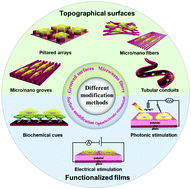
Mater. Chem. Front., 2020,4, 3444-3471
https://doi.org/10.1039/D0QM00279H
Two dimensional semiconducting polymers
Synthetic chemistry towards two-dimensional semiconducting polymers (2DSPs) with planar π-conjugated structures is reviewed and their unique chemical and physical properties derived from the extended π-conjugation are discussed.
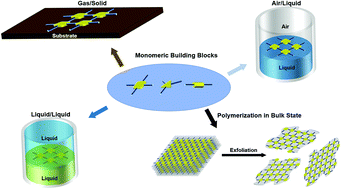
Mater. Chem. Front., 2020,4, 3472-3486
https://doi.org/10.1039/D0QM00309C
Recent advances of stable Blatter radicals: synthesis, properties and applications
Radicals, organic molecules with unpaired electrons, are applied across different scientific disciplines such as electronics, energy storage and biochemistry.
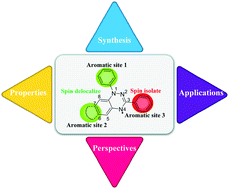
Mater. Chem. Front., 2020,4, 3433-3443
https://doi.org/10.1039/D0QM00122H
Recent advances in high-performance organic solar cells enabled by acceptor–donor–acceptor–donor–acceptor (A–DA′D–A) type acceptors
In this review, we focus on the recent advances in organic solar cells enabled by A–DA′D–A type acceptors and summarize the correlation between molecular structure, molecular packings, optoelectronic properties, and photovoltaic performance.
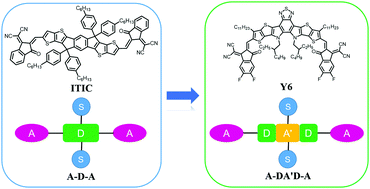
Mater. Chem. Front., 2020,4, 3487-3504
https://doi.org/10.1039/D0QM00305K
Structured and functionalized organic semiconductors for chemical and biological sensors based on organic field effect transistors
This review gives an overview of strategies to tailor organic semiconductors with designed physical structures and chemical functionalities for development of chemical and biological sensors based on organic field effect transistors.
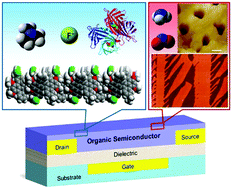
Mater. Chem. Front., 2020,4, 3505-3520
https://doi.org/10.1039/D0QM00202J
Two-dimensional halide perovskites featuring semiconducting organic building blocks
A timely review of recent exciting progress is provided regarding the molecular design, optical characterization, and device fabrications of novel 2D halide perovskite materials incorporating functional organic semiconducting building blocks.
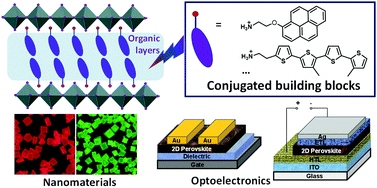
Mater. Chem. Front., 2020,4, 3400-3418
https://doi.org/10.1039/D0QM00233J
Recent progress in well-defined higher azaacenes (n ≥ 6): synthesis, molecular packing, and applications
In this review, we will focus on the recent progress in the synthetic strategies, photo-electronic properties, molecular packing modes and applications of azaacenes (n ≥ 6) with single-crystal structures.

Mater. Chem. Front., 2020,4, 3419-3432
https://doi.org/10.1039/C9QM00656G
Cyclobutene based macrocycles
Nanoscopic macrocycles could have unusual magnetic, optical, and electronic properties when compared to their linear counterparts.

Mater. Chem. Front., 2020,4, 3529-3538
https://doi.org/10.1039/D0QM00824A
Purity of organic semiconductors as a key factor for the performance of organic electronic devices
Effects of purification were studied in organic field effect transistors. The results presented here indicate that the purity of organic semiconductors is a key parameter to achieve high performance for the field of organic field effect transistors.
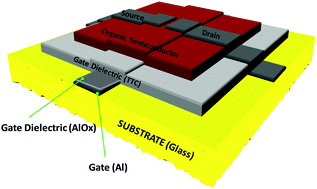
Mater. Chem. Front., 2020,4, 3678-3689
https://doi.org/10.1039/D0QM00690D
Pressure-induced valence transition in the mixed-valence (Sm1/3Ca2/3)2.75C60 fulleride
The mixed-valence (Sm1/3Ca2/3)2.75C60 fulleride undergoes an abrupt strongly hysteretic reversible phase transition accompanied by a drastic increase in the bulk Sm valence by ∼20% to +2.71 through the application of external pressure.
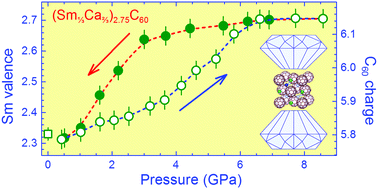
Mater. Chem. Front., 2020,4, 3521-3528
https://doi.org/10.1039/D0QM00707B
Band gap engineering of donor–acceptor co-crystals by complementary two-point hydrogen bonding
Hydrogen bonding of diindolopyrrole donors with quinone acceptors enhances the orbital interactions and modulates the band gap and electrical properties of their complexes.
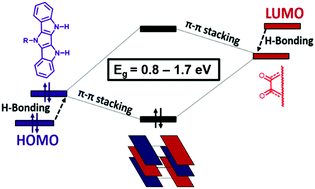
Mater. Chem. Front., 2020,4, 3669-3677
https://doi.org/10.1039/D0QM00500B
Pendant conjugated molecules based on a heterogeneous core structure with enhanced morphological and emissive properties for organic semiconductor lasing
A set of oligofluorene-type pendant conjugated molecules based on heterogeneous core structures (C1 and C2) with enhanced morphological and emissive properties have been synthesized and explored as gain media for organic semiconductor lasers.

Mater. Chem. Front., 2020,4, 3660-3668
https://doi.org/10.1039/D0QM00418A
Ultrafast photoinduced electron transfer in conjugated polyelectrolyte–acceptor ion pair complexes
Conjugated polyelectrolytes (CPEs) are a promising class of materials for photovoltaic and sensing applications due to their ability to undergo efficient photoinduced electron transfer (ET).

Mater. Chem. Front., 2020,4, 3649-3659
https://doi.org/10.1039/D0QM00476F
Synthesis and excited state processes of arrays containing amine-rich carbon dots and unsymmetrical rylene diimides
This work reports on the preparation of carbon dots (CDs) and rylene diimide hybrids and their spectroscopic investigation reveals complex inter-chromophoric interactions.
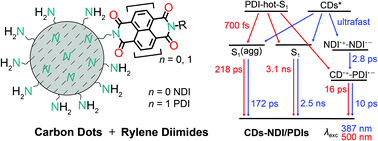
Mater. Chem. Front., 2020,4, 3640-3648
https://doi.org/10.1039/D0QM00407C
Doping molecular organic semiconductors by diffusion from the vapor phase
Spiro-OMeTAD can be doped by infiltration of F4TCNQ from the vapor phase without causing crystallization. Optical spectroscopy and thermopower measurements examined the question of the formation of dication states by charge transfer doping.
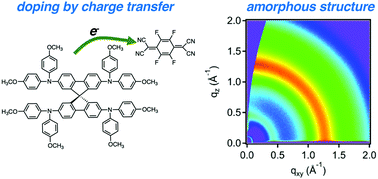
Mater. Chem. Front., 2020,4, 3632-3639
https://doi.org/10.1039/D0QM00442A
Electronic, vibrational, and charge-transport properties of benzothienobenzothiophene–TCNQ co-crystals
The electronic, optical, vibrational, and charge-transport properties of a series of benzothienobenzothiophene–TCNQ co-crystals are discussed on the basis of density functional theory calculations.
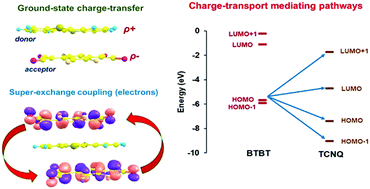
Mater. Chem. Front., 2020,4, 3623-3631
https://doi.org/10.1039/D0QM00420K
Exploiting trifluoromethyl substituents for tuning orbital character of singlet and triplet states to increase the rate of thermally activated delayed fluorescence
This work shows that trifluoromethyl (CF3) substituents can be used to increase the rate of thermally activated delayed fluorescence (TADF) in conjugated organic molecules by tuning the excitonic character of the singlet and triplet excited states.
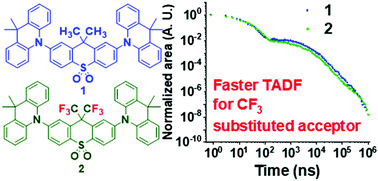
Mater. Chem. Front., 2020,4, 3602-3615
https://doi.org/10.1039/D0QM00429D
A new family of liquid and solid guanidine-based n-type dopants for solution-processed perovskite solar cells
A new family of n-type dopants for organic semiconductors is reported. Changing the alkyl chain of these triazabicyclodecene (TBD) dopants alters their physical properties, including thermal stability, and influences their doping efficiency.
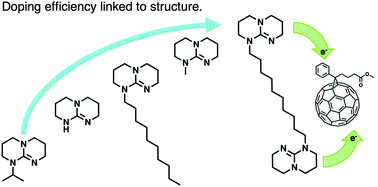
Mater. Chem. Front., 2020,4, 3616-3622
https://doi.org/10.1039/D0QM00437E
An oxygen heterocycle-fused fluorene based non-fullerene acceptor for high efficiency organic solar cells
A new acceptor–donor–acceptor (A–D–A) small molecule acceptor, named FCO-2F, is designed and synthesized based on the previous acceptor F-H.
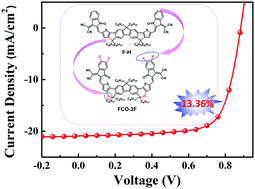
Mater. Chem. Front., 2020,4, 3594-3601
https://doi.org/10.1039/D0QM00287A
Protonic acid doping of low band-gap conjugated polyions
Conjugated polyions (CPIs) offer synthetic tunability and selective processing into insulating, semiconducting and metallic states simply by controlling acidity.
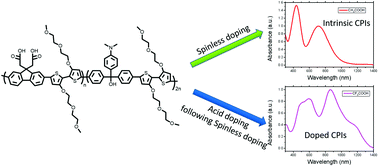
Mater. Chem. Front., 2020,4, 3585-3593
https://doi.org/10.1039/D0QM00278J
Fluoro-alkyl substituted isothianaphthene bisimides as stable n-type semiconductors
Two fluoro-alkyl substituted isothianaphthene bisimide materials with high solubility and their applications in stable n-type OTFTs are demonstrated.
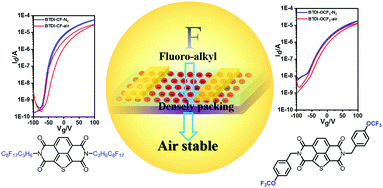
Mater. Chem. Front., 2020,4, 3578-3584
https://doi.org/10.1039/D0QM00137F
Understanding of copolymers containing pyridine and selenophene simultaneously and their polarity conversion in transistors
Two n-type pyridine and selenophene-containing polymers were synthesized and the structure–property relationships were investigated, followed by polarity switching from ambipolarity to unipolar characteristics via the doping method.
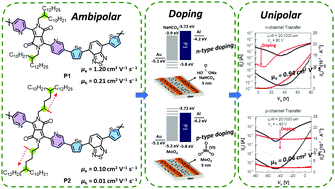
Mater. Chem. Front., 2020,4, 3567-3577
https://doi.org/10.1039/C9QM00739C
The importance of sulfonate to the self-doping mechanism of the water-soluble conjugated polyelectrolyte PCPDTBT-SO3K
In-depth understanding of the doped and de-doped states of CPE-K, a unique, water-soluble, highly conductive polymer.

Mater. Chem. Front., 2020,4, 3556-3566
https://doi.org/10.1039/D0QM00073F
Anthracene derivative based multifunctional liquid crystal materials for optoelectronic devices
A liquid crystal molecule with versatile properties, like the indicators of a clock, shows various applications.
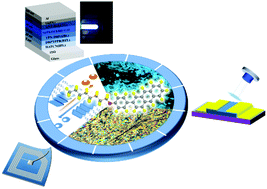
Mater. Chem. Front., 2020,4, 3546-3555
https://doi.org/10.1039/D0QM00038H
Perylene monoimide and naphthalene-annulated [3,3,3]propellanes: synthesis and device applications
3D polycyclic aromatic hydrocarbons are synthesized, and their applications for organic field-effect transistors and organic light-emitting diodes are explored.
![Graphical abstract: Perylene monoimide and naphthalene-annulated [3,3,3]propellanes: synthesis and device applications](/en/Image/Get?imageInfo.ImageType=GA&imageInfo.ImageIdentifier.ManuscriptID=C9QM00668K&imageInfo.ImageIdentifier.Year=2020)
Mater. Chem. Front., 2020,4, 3539-3545
https://doi.org/10.1039/C9QM00668K
About this collection
Welcome to Materials Chemistry Frontiers special collection celebrating Prof. Fred Wudl’s 80th Birthday.
Professor Fred Wudl is one of the pioneers of the modern organic materials chemistry, and has made a great contribution and achieved several milestones for this area, including the pioneering works of organic conductors for TCNQ/TTF, OPV’s PCBM etc. Contributed by Professor Wudl’s former co-workers and friends, this special collection covers all aspects of organic semiconductors including synthesis and theoretical investigation as well as their properties or applications related to display technologies, optical materials, magnetics and electronics.
Guest Editors: Qichun Zhang (Nanyang Technical University), Dmitrii Perepichka (McGill University), Hong Meng (Peking University, Shenzhen Graduate School) and Yongsheng Chen (Nankai University)
More articles will be added as soon as they are published.